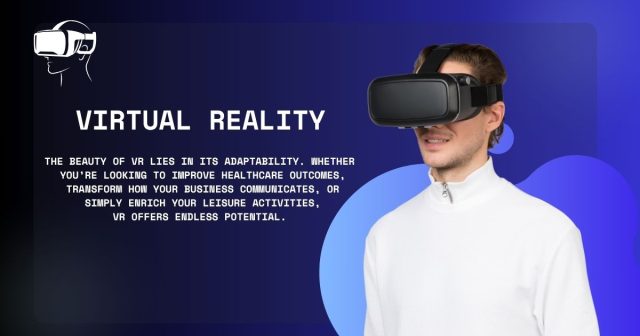Virtual Reality (VR) has gone beyond the limits of science fiction and has become a transformational force in the modern world. When a niche technology is limited to gaming enthusiasts, VR now gives shape to industries and how we work, teacher, teacher, act and even take care of our health. It provides immersive experiences that link users to three dimensions, which create incredible opportunities.
This blog dives into VR’s development, explains how it is adopted in industries, and it has been highlighted how it provides revolution in daily life. Whether you are a technically enthusiastic or just eager about how VR can affect you, this guide gives a wide look in this dynamic technique.
Understanding Virtual Reality
To start, what exactly is VR? It refers to a data -related simulation that immerses itself in an interactive, three -dimensional environment. Unlike traditional screen -based media, VR provides an experienced approach that stimulates many senses such as vision, sound and sometimes touch.
By using the VR headset as Okulus Quest, PlayStation VR or HTC Vivek, individuals can detect the digital world or follow real landscapes. For example, by entering a VR application, you can reach the top of Mount Everest, a stir sharescape or even a wide simulation of the human body.
Originally heavy and banned expensive, VR technology has traveled far. Today’s equipment is smooth, more cheap and accessible, making them viable tools in different fields.
The Evolution of Virtual Reality
While VR is often associated with cutting-edge technology, its development traces back to the mid-20th century:
- 1960s Innovations: The Sensorama, created by Morton Heilig, offered one of the first immersive experiences using visuals, sound, and even smells.
- 1980s Milestones: The creation of head-mounted displays (HMDs) laid the groundwork for the VR systems we see today.
- Consumer Revolution of the 2010s: The release of the Oculus Rift, followed by its acquisition by Facebook (Meta), brought VR to a wider audience, proving its potential across domains beyond gaming.
Advances in AI, computing power, and network bandwidth (including 5G) have significantly contributed to the expanding capabilities of VR systems. With a projected market value exceeding $87 billion by 2030, VR is positioned to play a defining role in various industries.
Read our latest blog Graphic Assets Online
Transforming Industry Through Virtual Reality
While VR may be best known for revolutionizing gaming, its applications extend to healthcare, education, retail, and more. Here’s how VR is making its impact across these sectors:
Healthcare Transformation
VR is changing the face of medicine with innovative applications in diagnostics, treatment, and training. Some of its standout uses include:
- Surgical Training: Platforms like Osso VR simulate complex surgical procedures, helping medical professionals refine their skills in a risk-free virtual environment.
- Therapy and Rehabilitation: VR proves invaluable in treating phobias, PTSD, and chronic pain. Patients can undergo exposure therapy or participate in engaging physical therapy routines within simulated experiences.
- Pain Management: Distraction-focused VR programs help reduce the discomfort felt by patients during treatments such as wound care or chemotherapy.
Advancing Education and Training
VR is redefining how knowledge is shared, from grade-school classrooms to corporate environments:
- Interactive Learning: Educational platforms like Engage enable students to explore historical landmarks or planetary systems in a virtual setting, turning lessons into engaging experiences.
- Job Simulations: Industries like aviation and construction use VR to provide hands-on training without real-world risks.
- Inclusive Education: Customizable VR content supports students with special needs, ensuring personalized and accessible learning experiences.
Retail and E-Commerce Revolution
Shopping is no longer confined to stores or static online platforms. VR is transforming how people browse, interact with, and purchase products:
- Virtual Showrooms: Retailers like IKEA and Sephora allow customers to walk through virtual stores or try products virtually before buying.
- Enhanced Retail Experience: Offering 3D previews of products, VR apps make online shopping more immersive, helping customers make confident decisions.
Entertainment and Media
While gaming remains a major driver of VR adoption, its applications in other entertainment fields are expanding:
- Immersive Films: Filmmakers are exploring VR to create 360-degree movies that place viewers in the heart of the narrative.
- Virtual Concerts and Events: Imagine attending concerts or sports events from your living room with a front-row VR experience.
- Social VR: Platforms like AltspaceVR and Meta’s Horizon Worlds are creating online spaces where users can connect, interact, and build communities in shared virtual environments.
Revolutionizing Work with VR
The rise of remote work has led companies to explore VR’s potential in collaboration and workspace virtualization:
- Virtual Workspaces: Tools like Spatial and Horizon Workrooms create immersive virtual offices that encourage collaboration, no matter where team members are located.
- Employee Training: Businesses use VR to train employees in complex tasks or soft skills, such as customer service and conflict resolution.
The Future of Virtual Reality
With such diverse applications, VR is paving the way for a more connected and accessible future. But where is the technology headed next? Here are some trends shaping the future of VR:
- Smarter Devices: Advances in AI will enable VR systems to create even more personalized and intuitive experiences.
- Affordability: Continuing innovation will make VR hardware and software more cost-effective for individuals and businesses alike.
- Cross-Industry Expansion: From real estate virtual tours to advanced military simulation training, VR will continue integrating into unexpected sectors.
How Will VR Impact Your Life?
t VR lies in its adaptability. Whether you want to improve the health care results, change how your business communicates, or just enrich your holiday activities, provides endless capacity. In addition to technology, it has only become a tool for connection, innovation and development.
It is interested in finding out how VR can fit in your life or work? Explore the latest VR technologies and start receiving the benefits of this transformation equipment today.



